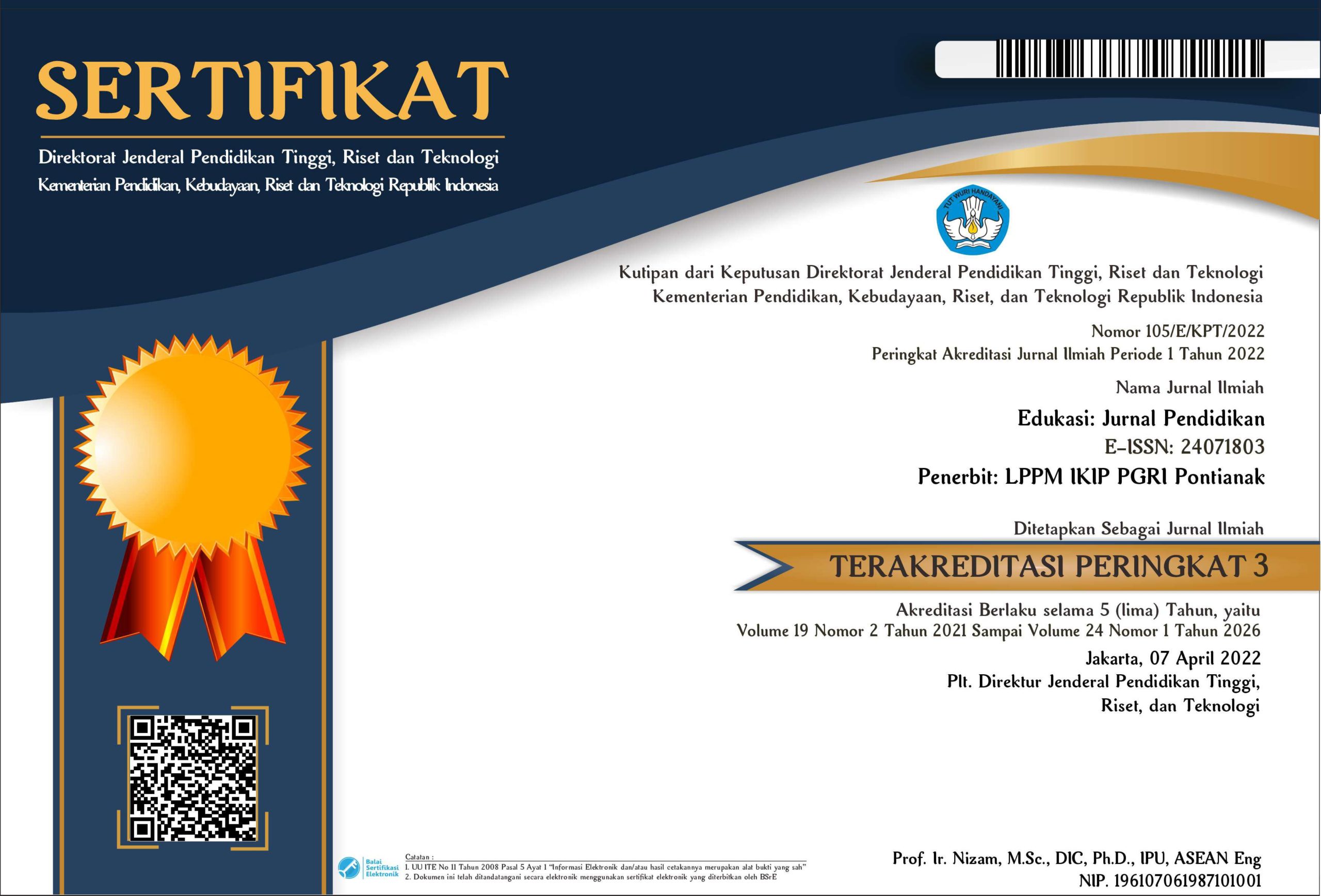Hasil Belajar Mahasiswa: Analisis Butir Soal Tes
DOI:
https://doi.org/10.31571/edukasi.v20i1.3432Keywords:
analisis butir, soal tes, kategori soal tes, item analysis, test questions, test question categoryAbstract
Abstrak
Tujuan penelitian untuk menguji validitas, reliabilitas, indeks kesukaran, dan daya beda soal tes untuk mahasiswa. Populasi penelitian adalah mahasiswa jurusan Teknik Otomotif UNP sebanyak 28 orang. Sampel penelitian dipilih dengan teknik total sampling sehingga keseluruhan populasi menjadi sampel penelitian. Teknik pengumpulan data dilakukan dengan dokumentasi yaitu berupa pemberian dan pengumpulan soal tes; kunci jawaban; dan lembar jawaban soal tes. Analisis data menggunakan teknik analisis deskriptif kuantitatif. Hasil analisis data menghasilkan tingkat validitas, reliabilitas, indeks kesukaran, dan daya beda soal tes. Hasil analisis data yaitu soal tes kategori valid, indeks reliabilitas soal pada kriteria reliabilitas tinggi, indeks kesukaran dengan kategori butir soal baik/layak, dan daya pembeda butir soal termasuk klasifikasi soal yang baik. Berdasarkan hasil penelitian, maka disimpulkan bahwa soal tes yang diberikan kepada mahasiswa layak untuk digunakan sebagai salah satu tes untuk mengukur kemampuan kognitif mahasiswa.
Â
Abstract
The purpose of the research was to see the level of validity, reliability, index of difficulty, and differentiating power of student test questions. The research population were 28 students majoring in Automotive Engineering of UNP. The research sample was selected using a total sampling technique, so that the entire population became the research sample. Data collection techniques used documentation in the form of giving and collecting test questions; answer key; and the answer sheet for the test. Data analysis used quantitative descriptive analysis techniques. The results of data analysis will produce levels of validity, reliability, index of difficulty, and differentiating power of test questions. The results of the data analysis concluded that the test items were in the valid category, the reliability index of the questions on the criteria of high reliability, the difficulty index with the category of good/decent items, and the discriminating power of the items including the good classification of questions. Based on the results of the research, it was concluded that the test questions given to students deserved to be used as a test to measure students' cognitive abilities.
Downloads
References
Agustiana, M., Mayrita, H., & Muchti, A. (2019). Analisis Butir Soal Ulangan Akhir Semester Mata Pelajaran Bahasa Indonesia Kelas XI. Jurnal Ilmiah Bina Edukasi, 11(01), 26-35. https://doi.org/10.33557/jedukasi.v11i01.203.
Amalia, A. N., & Widayati, A. (2012). Analisis Butir Soal Tes Kendali Mutu Kelas XII SMA Mata Pelajaran Ekonomi Akuntansi di Kota Yogyakarta Tahun 2012. Jurnal Pendidikan Akuntansi Indonesia, 10(1), 1-26. https://doi.org/10.21831/jpai.v10i1.919.
Anggraini, A., Sudiyanto, S., & Indrawati, C. D. S. (2020). The Effectiveness of the Problem-Based Learning Model Using Peer Assessment in Vocational High School. Jurnal Pendidikan Vokasi, 10(2), 159-166. https://doi.org/10.21831/jpv.v10i2.30956.
Anita, A., Tyowati, S., & Zuldafrial, Z. (2018). Analisis Kualitas Butir Soal Fisika Kelas X Sekolah Menengah Atas. Edukasi: Jurnal Pendidikan, 16(1), 35-47. https://doi.org/10.31571/edukasi.v16i1.780.
Arikunto, S. (2016). Prosedur Penelitian Suatu Pendekatan Praktik. Jakarta: Rineka Cipta.
Arpan, M., & Marpanaji, E. (2015). Faktor-Faktor Eksternal yang Memengaruhi Hasil Belajar Pemrograman Komputer Mahasiswa PTIK STKIP PGRI Pontianak. Jurnal Pendidikan Vokasi, 5(2), 195-208. https://doi.org/10.21831/jpv.v5i2.6392.
Hapnita, W. (2018). Faktor Internal dan Eksternal yang Dominan Mempengaruhi Hasil Belajar Menggambar dengan Perangkat Lunak Siswa Kelas XI Teknik Gambar Bangunan SMK N 1 Padang Tahun 2016/2017. CIVED (Journal of Civil Engineering and Vocational Education), 5(1), 2175-2182. https://doi.org/10.24036/cived.v5i1.9941.
Kemp, N., & Grieve, R. (2014). Face-to-Face or Face-to-Screen? Undergraduates’ Opinions and Test Performance in Classroom vs. Online Learning. Frontiers in Psychology, 5(11), 1-11. https://doi.org/10.3389/fpsyg.2014.01278.
Kolte, V. (2015). Item Analysis of Multiple Choice Questions in Physiology Examination. Indian Journal of Basic and Applied Medical Research, 4(4), 320-326.
Kumar, P., Sharma, R., Rana, M., & Gajjar, S. (2014). Item and Test Analysis to Identify Quality Multiple Choice Questions (MCQS) from an Assessment of Medical Students of Ahmedabad, Gujarat. Indian Journal of Community Medicine, 39(1), 17-20. https://doi.org/10.4103/0970-0218.126347.
Kusumawati, M., & Hadi, S. (2018). An Analysis of Multiple Choice Questions (MCQS): Item and Test Statistics from Mathematics Assessments in Senior High School. Research and Evaluation in Education, 4(1), 70-78. https://doi.org/10.21831/reid.v4i1.20202.
Mania, S., Fitriani, F., Majid, A. F., Ichiana, N. N., & Abrar, A. I. P. (2020). Analisis Butir Soal Ujian Akhir Sekolah. Al Asma: Journal of Islamic Education, 2(2), 274-284. https://doi.org/10.24252/asma.v2i2.16569.
Maulana, D., & Sanusi, A. (2020). Analisis Butir Soal Bahasa Arab Ujian Akhir Madrasah Bersama Daerah (UAMBD) Madrasah Ibtidaiyah Tahun 2017-2018. Ta'lim al-'Arabiyyah: Jurnal Pendidikan Bahasa Arab & Kebahasaaraban, 4(1), 12-24. https://doi.org/10.15575/jpba.v4i1.8054.
McAllister, D., & Guidice, R. M. (2012). This is Only a Test: A Machine-Graded Improvement to the Multiple-Choice and True-False Examination. Teaching in Higher Education, 17(2), 193-207. https://doi.org/10.1080/13562517.2011.611868.
Peraturan Menteri Pendidikan dan Kebudayaan Nomor 43 Tahun 2019 tentang Penyelenggaraan Ujian yang Diselenggarakan Satuan Pendidikan dan Ujian Nasional dalam https://peraturan.bpk.go.id/Home/Details/175176/permendikbud-no-43-tahun-2019. Diakses 18 Mei 2022.
Retnowati, D., Fatchan, A., & Astina, I. (2016). Prestasi Akademik dan Motivasi Berprestasi Mahasiswa S1 Pendidikan Geografi Universitas Negeri Malang. Jurnal Pendidikan: Teori, Penelitian, dan Pengembangan, 1(3), 521-525. http://dx.doi.org/10.17977/jp.v1i3.6181.
Saputra, H. D., Ismet, F., & Andrizal, A. (2018). Pengaruh Motivasi terhadap Hasil Belajar Siswa SMK. Invotek: Jurnal Inovasi Vokasional dan Teknologi, 18(1), 25-30. https://doi.org/10.24036/invotek.v18i1.168.
Saputra, H., Setiawan, D., Muslim, M., Amin, B., & Putra, R. (2021). The Effect of E-Learning Media on the Improvement of Learning Outcomes in the Vehicle Body Construction Course for Students of the Department Automotive Faculty of Engineering UNP. Invotek: Jurnal Inovasi Vokasional dan Teknologi, 21(1), 69-76. https://doi.org/10.24036/invotek.v21i1.893.
Saputra, H. D., Setiawan, D., Yuvenda, D., Arif, A., & Hidayat, R. (2019). Peningkatan Kompetensi Siswa melalui Pelatihan Teknologi Sepeda Motor. Suluah Bendang: Jurnal Ilmiah Pengabdian Kepada Masyarakat, 19(3), 127-134. https://doi.org/10.24036/sb.0180.
Sulistiawan, C. H. (2016). Kualitas Soal Ujian Sekolah Matematika Program IPA dan Kontribusinya terhadap Hasil Ujian Nasional. Jurnal Penelitian dan Evaluasi Pendidikan, 20(1), 1-10. https://doi.org/10.21831/pep.v20i1.7516.
Susanto, A. (2013). Teori Belajar dan Pembelajaran di Sekolah Dasar. Jakarta: Kencana.
Sutjiato, M., Kandou, G. D., & Tucunan, A. A. T. (2015). Hubungan Faktor Internal dan Eksternal dengan Tingkat Stress pada Mahasiswa Fakultas Kedokteran Universitas Sam Ratulangi Manado. JIKMU, 5(1), 30-42.
Zohrabi, M. (2013). Mixed Method Research: Instruments, Validity, Reliability and Reporting Findings. Theory and Practice in Language Studies, 3(2), 254-262. https://doi.org/10.4304/tpls.3.2.254-262.
Downloads
Published
How to Cite
Issue
Section
License
Authors who publish in this journal agree to the following terms:
- Authors retain copyright and grant the journal the right of first publication with the work simultaneously licensed under a Creative Commons Attribution License (CC-BY-NC) that allows others to share the work with an acknowledgment of the work's authorship and initial publication in this journal.
- Authors are able to enter into separate, additional contractual arrangements for the non-exclusive distribution of the journal's published version of the work (e.g., post it to an institutional repository or publish it in a book), with an acknowledgment of its initial publication in this journal.
- Authors are permitted and encouraged to post their work online (e.g., in institutional repositories or on their website) prior to and during the submission process, as it can lead to productive exchanges, as well as earlier and greater citation of published work.

 Download: 538
Download: 538


















